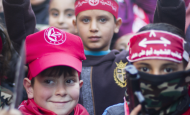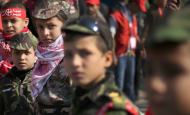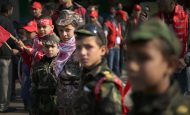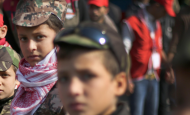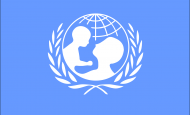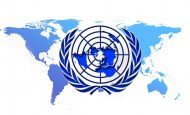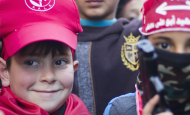UN Adopts Invented NGO Claims on Palestinian Minors to Threaten Israel with Blacklist
On July 11, the UN Secretary-General released his annual report on Children in Armed Conflict (CAAC), dealing with the violation of children’s rights in conflict zones in 2021. This year, the UN again presents misleading statistics and adopts invented standards in order to advance a narrative that the IDF violates the rights of Palestinian minors. This is the result of a yearslong campaign spearheaded by terror-linked and BDS-supporting NGOs, in concert with UNICEF.
Notably, the report includes an explicit threat to include the IDF for the first time on a “blacklist” of child rights abusers – alongside terrorist organizations such as ISIS, Al-Qaeda, and the Taliban – absent “meaningful improvement.”
Background: What Is the Blacklist?
The UN Secretary-General has published a yearly report on “Children and Armed Conflict,” which includes a blacklist or annex listing “parties to armed conflict” that engage in “grave violations” that fundamentally breach children rights. The declared purpose of the annex is to focus the “Security Council on specific parties, whether states or non-state actors” and take “targeted measures against violators, including the possibility of sanctions” (emphasis added). To date, the annex almost entirely consists of failed states, state-sponsored militias, and terrorist organizations such as ISIS, Boko Haram, the Taliban, and Al-Qaeda.
The five “grave violations” that trigger inclusion in this annex are:
- Killing or maiming of children
- Recruitment or use of children by armed forces or armed groups
- Attacks on schools or hospitals
- Rape or other sexual violence against children
- Abduction of children
Reliance on Terror-linked and Pro-BDS NGOs
The Secretary-General’s report claims that the UN verified all claims therein. In the context of the Israeli-Palestinian conflict, UNICEF is supposed to provide “factual information on patterns of violations and efforts made to end and prevent them, which may inform the SRSG’s [Special Representative for Children and Armed Conflict] listing recommendations and subsequent decisions by the SG [Secretary-General].”
However, NGO Monitor research shows that allegations concerning Israel primarily originate from a group of radical NGOs, with limited credibility, part of a “working group” that advances a campaign to demonize Israel in the Secretary-General’s annual report and seek to have Israel added to the annex. Based on the fundamental problems with the data on Israel (see below), as well as UNICEF’s involvement in this politicized anti-Israel campaign, UN verification is not a approbative factor.
This “working group” includes Defense for Children International-Palestine (DCI-P), designated as a terrorist entity by Israel in October 2021 over its ties to the Popular Front for the Liberation of Palestine (PFLP) terrorist organization.1 It also includes other PFLP-linked groups –Al-Mezan and the Palestinian Centre for Human Rights (PCHR) – and NGOs such as B’Tselem that label Israel an “apartheid” state and lobby governments and international institutions to sanction Israel.2
It is also important to note that all information regarding Gazan casualties is provided by the Hamas-run local Ministry of Health. In other words, in addition to terror-linked NGOs, the CAAC report relies heavily on Hamas-generated data.
Inconsistencies with CAAC Reporting and Classification Standards
The majority (54%) of “grave violations” attributed to Israel are linked to the delay or denial of permit applications for Gazans who sought medical treatment in Israel. Scant details or references are provided to verify such claims. Regardless, contrary to the UN’s premise, Israel is not obligated to allow residents of Gaza into Israel for medical treatment, much as it has no obligation to allow access within its borders to any other group of non-Israelis living outside of the country.
Moreover, data regarding passage between Israel and Gaza through the Erez Crossing strongly suggests that COVID restrictions played a large factor in determining the permit approval policy during the period covered in the Secretary-General’s report: Significant increases in approvals coincide with the implementation of Palestinian policies to increase vaccination rates.

Entry and exit through Erez crossing (Source: OCHA https://www.ochaopt.org/data/crossings)
Categories that Exist Only for Israel
A further sign of the influence of the NGO-led campaign to blacklist the IDF is the invention of standards that are unique to the Israeli-Palestinian conflict, and not applied by the UN anywhere else in the world.
-
Categorizing Tear gas as “Maiming”
According to the UN, the grave violation of “maiming” constitutes “Any action that causes a serious, permanent, disabling injury, scarring or mutilation to a child.” Consistent with this definition, throughout the report, “maiming” refers to “air strikes”; “targeted killings”; “gunshots”; “landmines”; “shelling”; “improvised explosive devices”; “torture”; “explosive remnants of war”; and “crossfire.” Except with regards to Israel.
According to the report, approximately 16% of “maiming of children by Israeli forces” was by tear gas, without any account of the severity of medical intervention, if any, needed for the incidents. Indeed, according to the US Center for Disease Control (CDC), the effects of teargas are “usually short-lived (15–30 minutes) after the person has been removed from the source and decontaminated (cleaned off)” – in sharp contrast to the “permanent” and “disabling” standards ostensibly applied by CAAC. This is the only mention of tear gas in the entire document, as it is not applied to any other conflict. (This singling out of Israel appeared in the 2019-2020 report as well.)
-
Detention of Minors
The report claims that the UN “verified the detention of 637 Palestinian children for alleged security offences by Israeli forces in the occupied West Bank, including 557 in East Jerusalem.” However, youth detention – a major theme of NGO advocacy to demonize Israel, including the work of PFLP-linked DCI-P, in conjunction with UNICEF – is not considered a grave violation in the CAAC framework.
Even if it were – the UN data is skewed by conflating West Bank and East Jerusalem incidents. Under Israeli law, all Jerusalem residents are subject to civilian procedures – arrested by civilian police force and tried in domestic courts. As such, 87% of detained minors are irrelevant for a discussion of “Children and Armed Conflict.”
Concerning the remaining 80 Palestinian minors, they were arrested for violent crimes, including terror offenses and attempted murder. Yet, the UN does not condemn their communities’ incitement to perpetrate these attacks. Indeed, more broadly the Secretary-General’s report largely ignores the incitement of Palestinian minors to commit violence against Israelis, and the recruitment of Palestinian children by terrorist organizations, one of the grave violations.
Since 2018, NGO Monitor has identified approximately 50 Palestinian teens killed while carrying out terrorist attacks, or during clashes with Israeli forces. This includes at least 14 that were affiliated with internationally designated Palestinian terrorist organizations such as Hamas, Palestinian Islamic Jihad, the Popular Front for the Liberation of Palestine (PFLP), and the Al-Aqsa Martyr’s Brigades. Since July 2017, at least 6 Israeli civilians have been murdered by Palestinian teenagers.
-
Attacks on Schools
In the past few years, UNICEF “working group” members have invented new, looser standards to allege Israeli violations towards Palestinian students and schools. This raises questions about how closely CAAC is adhering to its own standards for defining these violations.
The UN’s Guidance Note for attacks on schools (Guidance Note on Security Council Resolution 1998) requires that an incident must bear a “clear link” to education to be considered an attack on a school. The Guidance Note explains that a teacher targeted on his/her way to school would be a “listing violation,” but “where it is not possible to determine the link between the attack and the targeted person’s role as a provider of education or health care, the incident should not be included as an attack on related protected person.” Threats against schools must be specifically “directed toward a particular individual or group of persons related to the seeking or provision of education or health care.”
In an April 2020 publication on education in the West Bank, Save the Children – listed as a member of UNICEF’s “working group” – ignores the UN definition and applies a looser “definition” invented by a group of NGOs known as the “Global Coalition to Protect Education from Attack” (GCPEA).3 GCPEA defines attacks on education in a much broader way, with less needed to prove that a specific person or site was targeted due to its relationship to education.
Yet, Save the Children is forced to admit that even their own contrived standard is not sufficient to claim Israeli violations. It noted that “many of the incidents that children reported to us fall outside this definition, for example incidents relating to heavily armed military or settlers that make them feel unsafe in the classroom, or on their way to and from school. However, we give them equal weight and representation in this report” (emphasis added). In other words, precise assessment is a façade: the objective is clearly political advocacy.
It is in this context that the CAAC report’s inclusion of 45 incidents of “closures of checkpoints or the denial of teachers’ and students’ access through checkpoints,” should be considered.
Government Funding to “Blacklist” Campaign
The EU is a significant funder of the primary NGOs behind the campaign to list the IDF on the Secretary-General’s CAAC annex. Indeed, EU-funded grant descriptions emphasize advocacy and collaboration with the UN to extensively lobby international actors and governments and ensure accountability.
In addition, many of the reporting and advocacy benchmarks are established in advance of the project or any documented wrongdoing, encouraging NGO grantees to invent and inflate claims in order to comply with the grant requirements.Between 2018-2020 alone, the EU provided at least €3.2 million to projects that advance the campaign to “blacklist” the IDF, alongside at least $6.7 million from European countries (UK, Norway, Belgium, Switzerland, and others).
For instance, the EU disbursed €1.6 million to the Norwegian Refugees Council (NRC) in 2019-2020 for “Humanitarian Support to Protect Education from Attacks in West Bank, including East Jerusalem- phase IV”. France contributed $763,807 to this project in 2020.9 The project’s objectives included “Strengthening documentation, reporting, advocacy and communication (including dialogue with national and international authorities, and media outreach) on education-related violations,” as well as “Advocacy using field and desk research to produce materials, briefings and submissions to the international community in oPT, including EU and UN bodies and diplomatic missions, as well as EU and UN bodies based in Brussels, Geneva, and New York, and the U.S. Congress” (emphases added).
Similarly, in an earlier phase of this project to which the EU provided $929,000 in 2018, NRC was expected to produce three “education related advocacy materials (briefings, briefing documents, reports and formal complaints to UN special Mechanisms etc)” to “share[] with relevant stakeholders.” Additionally, officials in Brussels wanted “20 advocacy briefings on documented violations on the Right to Education,” and “3 instances when Third States and intergovernmental bodies condemn violations of the Right to Education” (emphases added).
In other words, it was already decided in advance of its work that the NRC would file complaints against Israel with the UN, and tangible success would be measured by lobbying and getting countries and intergovernmental bodies to condemn Israel.
(For more information on the European-funded campaign to blacklist the IDF, see NGO Monitor’s “Europe Funds Fraudulent Child Rights Campaign to Sanction Israel”.)
Footnotes
- In 2018, Citibank, Arab Bank, and Global Giving shut down DCI-P accounts and ceased providing services to the organization
- UNICEF no longer publishes a list of its NGO partners – reflecting a lack of transparency. As of September 2017, NGOs on the UNICEF “Working Group” included: DCI-P, PCHR, Al Mezan, B’Tselem, Terre Des Homme – Suisse, Save the Children, War Child Holland, World Vision, OCHA, UNESCO, UNRWA, UN Mine Action Service (UNMAS), and WHO.
